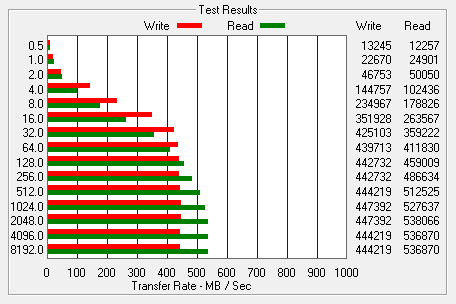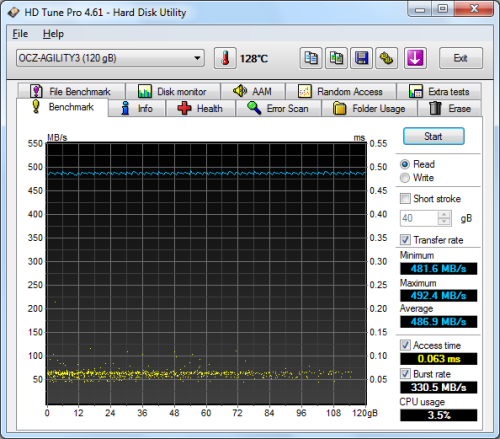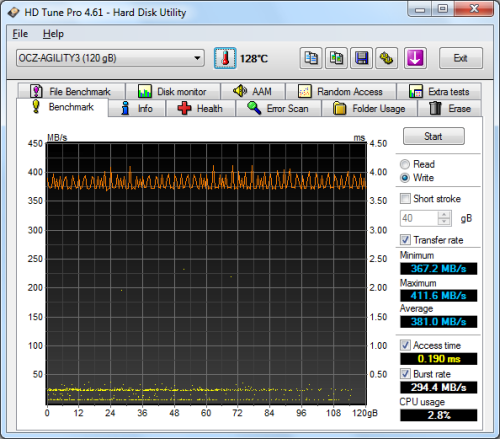![]()
![]()
Model: Silicon Power Velox Series V30 120GB Solid State Drive
Manufacturer: Silicon Power
Provided By: Silicon Power
Silicon Power is a relatively new name in the storage industry. Founded in 2003 by a group of professionals specializing in international business, global marketing and technical engineering, the company has already established itself as one of Taiwan's top manufacturers. With an eye for attractive and versatile design, Silicon Power has built its brand around the concept that its customers deserve products that represent who they are in life and mirror their personality. The end result is a variety of uniquely designed storage products including USB flash drives, memory cards and solid-state drives (SSD).
 The latest addition to Silicon Power's Velox Series of solid state drives is the V30. Available in capacities ranging from 60GB up to 480GB, the V30 is powered by SandForce's SF-2281 processor and features a SATA 6GB/s interface, native TRIM support and DuraWrite technology. Silicon Power's new SSD also uses MLC NAND flash to deliver up to 550MB/s read and 520MB/s write speeds as well as a maximum of 85,000 4KB random write IOPS. To top it all off, the V30 ships with an adapter for use in both notebook and desktop PCs and is covered by a three-year warranty.
The latest addition to Silicon Power's Velox Series of solid state drives is the V30. Available in capacities ranging from 60GB up to 480GB, the V30 is powered by SandForce's SF-2281 processor and features a SATA 6GB/s interface, native TRIM support and DuraWrite technology. Silicon Power's new SSD also uses MLC NAND flash to deliver up to 550MB/s read and 520MB/s write speeds as well as a maximum of 85,000 4KB random write IOPS. To top it all off, the V30 ships with an adapter for use in both notebook and desktop PCs and is covered by a three-year warranty.
| Silicon Power Velox Series V30 120GB Solid State Drive | |||||||||||||||||||||||||||||
General Specifications
Performance
Reliability
Environmental
Dimensions and Weight
Other Features
|
Needless to say, this is only a taste of what the V30 has to offer. To give you an idea of what to expect, we'll take a closer look at Silicon Power's new SSD and then see how well it performs. Does the V30 have what it takes? Can it deliver the value and performance we've come to expect from Silicon Power? Keep reading as we find out.
The V30 comes packaged in a brightly colored, retail box. The front advertises many of the drive's key features including its 120GB capacity, SATA III interface and 2.5-inch form factor. There is also a small, plastic window which lets you look inside the box and see what the V30 looks like. The back of the box provides a bit more information, including the drive's specifications and a longer list of features. Inside, you'll find the SSD, a 3.5" adapter bracket, mounting screws and a small installation guide.
![]()
Physical Features:
The V30 looks very similar to Silicon Power's other 2.5" SSDs. The drive's outer casing is made entirely out of metal and is covered by a textured, matte black finish. The top of the drive also has a large, red and orange sticker advertising its capacity as well as the fact that it is part of Silicon Power's V30 series.
![]()
![]()
As I mentioned earlier, the V30 uses SandForce's SF-2281 controller chip. The SF-2281 can be found in a number of other SSD's including the ADATA S511, Corsair Force Series 3, OWC Mercury 6G, Kingston HyperX, OCZ Vertex 3 and Patriot Pyro SE.
![]()
![]()
While earlier versions of the V30 featured synchronous NAND from Intel, the drive Silicon Power sent us for this review came equipped with Micron's 8GB 25nm 29F64G08CBAAA asynchronous NAND flash chips. Looking at the pictures above, you can see that there are eight of these chips on either side of the PCB. If you do the math, you'll see that this equals 128GB and not the 120GB of storage the drive advertises. The SandForce controller uses this extra 7% (8GB) to maximize performance and extend the endurance and overall reliability of the drive.
The test system used in this review was an HP 8200 Elite. The computer came equipped with an Intel Core i5-2400 CPU, 4GB of DDR3 1333MHz memory, Seagate Barracuda 7200.12 ST3250312AS 250GB SATA 6 Gb/s hard drive, NVIDIA Quadro FX580 512MB PCIe graphics card and an Intel 82579-LM gigabit network card. For the operating system, I installed a fresh copy of Windows 7 Enterprise.
To test the performance of the V30, I ran a series of benchmarks using CrystalDiskMark 3.0.1, HD Tach RW 3.0.4.0, ATTO Disk Benchmark 2.46, AS SSD, HD Tune Pro 4.61 and Iometer. For comparison, I've also included test results from the Plextor PX-256M2P, Kingston HyperX, OCZ Vertex 3 and OCZ Agility 3.
![]()
As I mentioned earlier, the V30 is based on SandForce's SF-2281 controller. Like other SandForce controllers, the SF-2281 features a technology called DuraWrite, which uses data compression to lower write amplification and extend the life of the drive by reducing the number of program-erase cycles. This data compression also plays a big part in the controller's performance. The more the data can be compressed, the faster an SSD like the V30 is able to read and write. Looking at the screenshot above, you can see that there is a considerable performance difference when writing incompressible (0%) and compressible (100%) data.
CrystalDiskMark 3.0.1:
First, I ran a few quick tests using CrystalDiskMark. This benchmark tool measures the performance of a storage device by testing its sequential read and write speeds as well as its random read and write speeds using blocks 512K and 4K in size.
According to Silicon Power, the 120GB V30 is capable of reading at 550MB/s and writing at 510MB/s when connected to a SATA 6 Gb/s port. The drive didn't come close to these numbers using CrystalDiskMark's default (random) test data. However, with the highly compressible 0x00 (0 Fill) data, the V30 was able to read at 468.7 MB/s and write at 456.6 MB/s.
HD Tach RW 3.0.4.0:
Next, I used HD Tach to test the V30's read, write and burst speeds as well as its seek times and CPU usage.
![]()
Looking at the screenshot above, you can see that the V30 had average read and write speeds of 361.5 MB/s and 340.9 MB/s respectively, as well as a burst speed of 364.6 MB/s.
ATTO Disk Benchmark 2.46:
I also used ATTO Disk Benchmark to test the V30's sequential read and write speeds. The tests are run using blocks ranging in size from 0.5KB to 8192KB and the total length set to 256MB.
When tested with ATTO, the V30's read speeds topped out at about 544 MB/s and its write speeds at 477 MB/s.
AS SSD:
AS SSD is a relatively new benchmark designed specifically for solid state drives. The application contains five synthetic tests used to determine the sequential and random read and write performance of a drive.
![]()
AS SSD also includes a copy benchmark. This test copies an ISO (two large files), program (many small files) and game (small and large files), returning the speed and duration of each.
![]()
HD Tune Pro 4.61:
Next, I ran a series of tests using HD Tune Pro. This hard disk utility measures a drive's performance by testing its sequential read and write speeds as well as its access time, burst rate and CPU usage. For this review, I'm also going to use it to benchmark the V30's random read and write speeds, random access times and the number of operations per second.
The V30 performed very well when benchmarked with HD Tune. The drive had average read and write speeds of 491.4 MB/s and 409.2 MB/s, respectively, as well as a burst rate of 329.6 MB/s when reading.
Silicon Power V30 120GB - HD Tune Random Access Read |
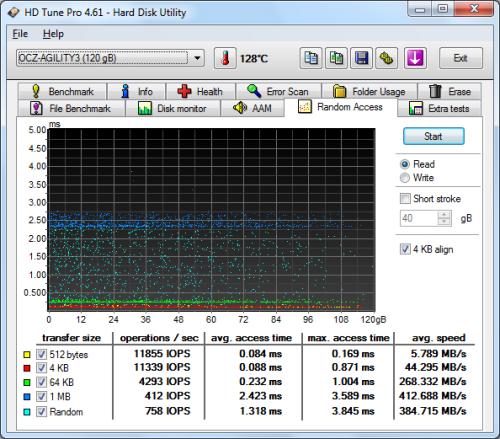 OCZ Agility 3 120GB - HD Tune Random Access Read |
Silicon Power V30 120GB - HD Tune Random Access Write |
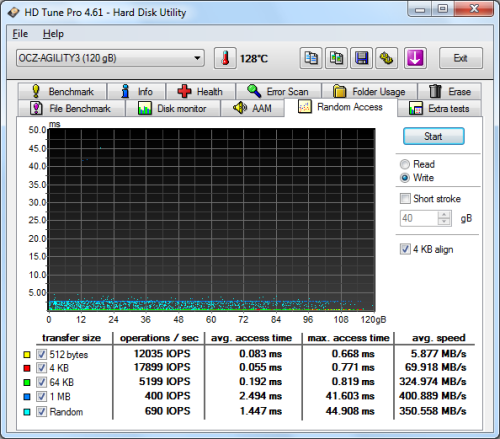 OCZ Agility 3 120GB - HD Tune Random Access Write |
The V30 didn't disappoint when doing random reads and writes. When reading 4KB blocks, the drive reached 12697 IOPS and had an average speed of 49.601 MB/s. The V30 was even faster when writing, reaching 16523 IOPS with an average speed of 64.544 MB/s.
Iometer:
Lastly, I ran a series of tests using Iometer. This tool can be configured to benchmark a number of things. In this case, I used it to measure the V30's read and write speeds and the number of operations per second. The tests were run using random bytes and a queue depth of 3.
![]()
The V30's performance was very similar to what we saw in our other tests. With highly compressible, repeating data, the drive was able to read at 501.01 MB/s and write at 460.06 MB/s. When tested with random data, the drive's read and write speeds dropped to 199.27 MB/s and 138.07 MB/s, respectively.
![]()
The V30 did not perform as well as some of the other SandForce-based drives when doing random reads and writes. Even with repeating data, it reached a maximum writing speed of only 144.41 MB/s.
![]()
According to Silicon Power, the V30 can deliver a maximum of 85,000 IOPS when randomly writing 4K blocks. The drive came no where near this number in our tests, reaching 33,841 IOPS with random data and 36,968 IOPS with repeating data.
TRIM Performance:
While SSDs offer many benefits, there are some downsides to using flash memory. One of the biggest issues people run into is performance degradation. Over time, an SSD will run out of fresh blocks and will have to write over data the file system has marked as deleted. This procedure is very complicated and can slow an SSD's write speeds considerably.
To address this problem, most manufacturers have added TRIM support to their SSDs. The TRIM command allows an operating system, such as Windows 7, to tell an SSD which data blocks are no longer in use. Using this information, the drive pro-actively erases these blocks and adds them to the free block pool.
![]()
To test the V30's TRIM function, I first put the drive in a "dirty" state. I used Iometer to fill the entire drive and then ran a random write test for 30 minutes. Looking at the screenshot below, you can see that the V30's average read and write speeds dropped to 115.4 MB/s and 172.1 MB/s, respectively.
![]()
Silicon Power V30 - Dirty
To see how well the V30 could recover, I let the computer sit for a few hours and then reran the test. The drive's average read speed climbed up to 266.0 MB/s. However, its write speed still lagged a bit behind, averaging out at 199.8 MB/s.
![]()
Silicon Power V30 - After Trim
Lastly, I used OCZ's Toolbox utility (yes, it works) to perform a secure erase on the V30. With the drive wiped clean, its write speed jumped back up to 332.6 MB/s.
![]()
Silicon Power V30 - Secure Erase
Final Thoughts:
The Velox Series V30 is the first SSD from Silicon Power to come through the 'Labs. Like many of the drives on the market today, it's based on SandForce's popular SF-2281 controller and comes equipped with a 6Gb/s SATA interface. Early reviews showed that the V30 was capable of delivering performance on par with high-end drives from companies like Kingston, OCZ and Patriot, but with the drive Silicon Power sent us, this really wasn't the case. Under ideal conditions, the V30 was able to read at speeds as high as 544 MB/s and write at speeds in excess of 460 MB/s. However, due to its use of asynchronous NAND, these numbers dropped considerably when working with incompressible data. On a more positive note, the drive supports TRIM and garbage collection technology and comes with a three year warranty as well as a 3.5" adapter bracket.
Performance aside, the biggest issue I have with the V30 is the switch from synchronous to asynchronous NAND. When asked about this, Silicon Power stated that, depending on market price, they may use NAND from different manufacturers. This isn't unheard of, but the switch to cheaper, asynchronous NAND is something that the consumer needs to be made aware of. Currently, there is no way to tell what type you're getting without opening the drive up (and voiding your warranty) or by running a few benchmarks and trying to figure it out that way. Instead, what Silicon Power really needs to do is sell these asynchronous equipped drives under a different SKU or model name and at a much lower price point.
The V30 is available now in 60GB, 120GB, 240GB and 480GB capacities. The 120GB reviewed here can be purchased from Amazon.com for about $225.
Highs:
- Available in 60GB, 120GB, 240GB and 480GB capacities
- Good sequential read and write speeds with compressible data
- SATA 6Gb/s interface
- Supports SMART, TRIM and garbage collection
- Equipped with DuraWrite and wear leveling
- Well constructed
- Includes a 2.5" to 3.5" adapter bracket
- 3 year warranty
Lows:
- No way to tell if you're getting a drive with asynchronous NAND
- Considerably slower with incompressible data
- Hard to find in some markets
- Pricey


